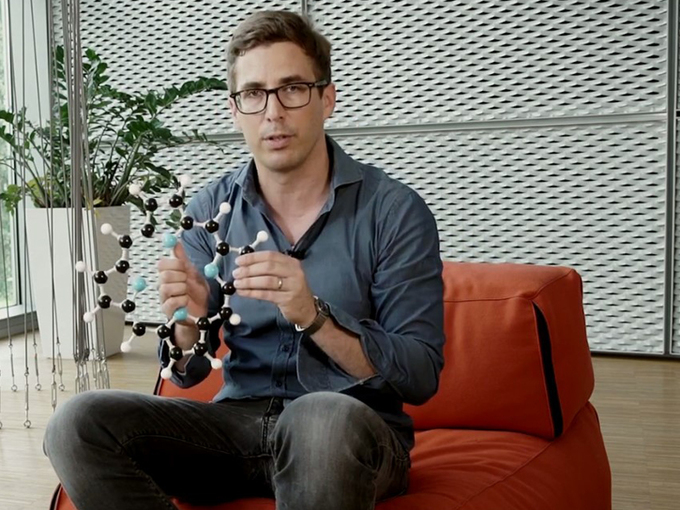Wissenschaftler verkuppeln zwei Stars der Chemie-Welt
Hybridmaterial eröffnet neue Möglichkeiten in der Anwendung von Graphen
2016-09-20 – Nachrichten aus dem Physik-Department
Kaum ein Material steht in der Forschung derzeit so im Mittelpunkt wie Graphen. Es ist flexibel, äußerst dünn und durchsichtig – dabei weist es eine extreme Zugfestigkeit auf und leitet elektrischen Strom. Ideale Voraussetzungen für viele Anwendungsbereiche. Für die Gewinnung von Solarenergie oder den Einsatz als Gas-Sensor sind aber noch andere spezifische Eigenschaften nötig. Dafür können Moleküle, die diese Eigenschaften aufweisen, an die Kohlenstoff-Schicht “angehängt” werden.
In bisherigen Arbeiten hatten Wissenschaftler vor allem versucht, mit sogenannten nasschemischen Methoden die Moleküle auf die Oberfläche des Materials zu bringen. Auwärter und seine Kollegen wählten einen anderen Ansatz. Im Ultrahochvakuum konnten sie kontrolliert Porphyrin-Moleküle an das Material binden. Dabei nutzen sie die katalytischen Eigenschaften einer Silberoberfläche, auf der die Graphenlage aufliegt. Durch Erhitzen verlieren die Porphyrin-Moleküle an ihren Rändern Wasserstoffatome und können so neue Bindungen mit den Graphenkanten eingehen.
Kontrollierte Reaktion
“Die Methode bietet ein sauberes und kontrolliertes Umfeld”, erklärt Wilhelm Auwärter, Professor für Molekulare Nanowissenschaften an Grenzflächen. “Wir können genau sehen, wie die Moleküle binden und welche Arten von Bindungen entstehen.” Dazu verwenden die Forscher modernste Rasterkraftmikroskopie, die es erlaubt die chemische Struktur einzelner Moleküle – deren atomares “Skelett” – direkt abzubilden.
Den Wissenschaftlern gelang es zum ersten Mal, funktionale Moleküle kovalent, also mit einer stabilen chemischen Bindung, an Graphenkanten anzubringen. “Es ist sinnvoll, nur die Kanten des Materials zu modifizieren, da so die positiven Eigenschaften des Graphens nicht zerstört werden”, sagt Auwärter.
Link: Video zum Thema auf Youtube**
Die Forscher wählten die Porphyrin-Moleküle wegen ihrer besonderen Eigenschaften. “Porphyrine sind beispielsweise verantwortlich für den Sauerstoff-Transport im Hämoglobin”, erklärt Auwärter. Je nachdem, welche Metalle sich im Zentrum befinden, verändern die Moleküle ihre Eigenschaften und können unterschiedliche Aufgaben übernehmen, etwa die spezifische Bindung von Gasmolekülen wie Sauerstoff und Kohlendioxid.
Mithilfe der neuen Methode könnten in Zukunft auch andere Moleküle mit Graphen verknüpft werden. Außerdem wollen die Forscher die Reaktion noch besser kontrollieren und Moleküle an Kohlenstoff-Nanostrukturen wie Graphenbänder anhängen, um diese gezielt zu modifizieren. Diese Nanostrukturen haben eine zentrale Bedeutung für elektronische Anwendungen.
Das Projekt wurde gefördert durch den Europäischen Forschungsrat, die Deutschen Forschungsgemeinschaft, den Exzellenzcluster “Munich Centre for Advanced Photonics”, das TUM Institute for Advanced Study und das siebte Forschungsrahmenprogramm der Europäischen Kommission.
Veröffentlichung
Verwandte Meldungen
- Kleine Kunstwerke mit großem Potential – 2016-07-13
- Stabile Bänder aus Porphin-Molekülen im Labor erzeugt – 2014-08-15
Kontakt
- Prof. Dr. Wilhelm Auwärter
- Technische Universität MünchenJames-Franck-Str. 185748 GarchingTel.: +49 89 289-12399E-Mail: wau@tum.de
